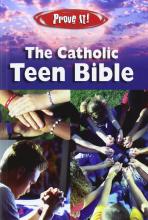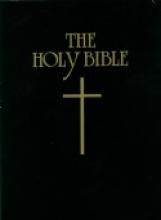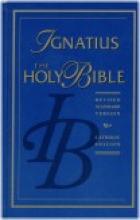Family Bibles
New American Bible with Revised New Testament and Revised Psalms
The New American Bible with Revised New Testament and Revised Psalms (RNAB) has several problems that prevent my recommending it for Bible study or devotional reading. These can be classed into three major groups: (1) failure with regard to dignity, beauty, and doctrinal precision, (2) bowing to the externally-imposed linguistic norm of so-called “inclusive language,” and (3) a skeptical attitude toward the Sacred Scriptures. Not incidentally, the second problem contributes significantly to the first, and shares roots with the third. Further, the Sacred Scriptures and the Sacred Liturgy are demeaned when turned into a vehicle for an ideological agenda in this manner.
While the original New American Bible (NAB) of 1970 was not particularly beautiful or dignified in its language, the remaining problems largely originate in the revisions made since. To give a single, but very representative example of the kind of problems introduced, let’s look at the scenes of the Annunciation and the Visitation in the first chapter of the gospel according to St. Luke.
In the original NAB, v35 (“The Holy Spirit will come upon you and the power of the Most High will overshadow you ...”) carries a footnote that begins: “The overshadowing of Mary recalls the cloud that covered with glory the Meeting Tent (Ex. 40:34f) and the temple of the Lord (1 Kgs. 8:10; Hg. 2:7).” That offers a beautiful and profound connection between the New Covenant and the Old.
The RNAB, however, has other ideas. The footnote above has been removed, and instead, a new note to verses 46-55 (the Magnificat) offers the following commentary on the origin of this prayer: “Because there is no specific connection of the canticle to the context of Mary's pregnancy and her visit to Elizabeth, the Magnificat (with the possible exception of v 48) may have been a Jewish Christian hymn that Luke found appropriate at this point in his story. Even if not composed by Luke, it fits in well with themes found elsewhere in Luke: ....” (!) So, in the RNAB, not only is Mary’s authorship of the Magnificat casually dismissed, but Luke is accused of putting it in because, essentially, it fit well with other stuff he’d written.
In contrast, let me share what scholar Catherine Brown Tkacz has lately written: “Only in recent decades have some biblical scholars ... asserted that Mary 'could not' have composed the Magnificat herself. ... It is worth noting that for nearly 2,000 years Christians had no difficulty in crediting Mary with the ability to understand her religious tradition and its scripture and to praise God in terms expressive of them.” (“Is the Education of Women a Modern Idea?” pp. 16-21, This Rock, Mar 2008)
The fact that the revisers of the NAB would have thought this new footnote to be more edifying than the one they removed is very telling.
Unfortunately, this is not an isolated problem. Indeed, the Holy See rejected the revised Psalms of the RNAB as unusable even as a base text for the Lectionary, because the revisions introduced doctrinal problems. And while the revised New Testament was used as a base text, hundreds of “amendments” (i.e. corrections) were required.
I’ll provide just a handful of examples from the RNAB demonstrating some of its problems. Fr. Neuhaus has written that it is, “not to put too fine a point on it, a wretched translation. It succeeds in being, at the same time, loose, stilted, breezy, vulgar, opaque, and relentlessly averse to literary grace.” (Rev. Richard John Neuhaus, “Bible Babel,” First Things, May 2001)
One verse that illustrates his point is 1 Cor. 12:28, which reads: “Some people God has designated in the church to be, first, apostles; second, prophets; third, teachers; then, mighty deeds; then, gifts of healing, assistance, administration, and varieties of tongues.” There is something very odd about “people” designated to be “mighty deeds,” “gifts of healing,” etc.
A gloss in place of a faithful rendition of the original creates a more serious problem in Ps. 103:11,13. In these verses, the phrase “those who fear Him” has been transformed into “the faithful.” This change was most likely made merely to eliminate the reference to the Lord as “Him,” but it has also eliminated the concept of “fear of the Lord” from Psalm 103. Forced removal of the masculine pronoun has compromised doctrinal precision.
A similar situation in the revised New Testament occurs in 1 Pt. 1:22, in which “sincere love of the brethren” (RSV) or “genuine love of your brothers” (1970 NAB) has been remodeled into “sincere mutual love.” It doesn’t take a linguistic expert to see that the RNAB rendition does not mean at all the same thing as the others. Mutuality or reciprocity is not the point here; rather every Christian is called to love his fellow Christians as brothers. Once again, doctrinal clarity is compromised.
My final example comes from the footnote to Psalm 58, verse 2. Readers may be familiar with this psalm, in which, as the NAB explains, “judges are called ‘gods’ in the sense of ‘possessing godlike power’ or of ‘taking God’s place in pronouncing judgment.”
The RNAB, however, provides a novel and frankly stunning explanation: “Gods: the Bible sometimes understands pagan gods to be lesser divine beings who are assigned by Israel's God to rule the foreign nations. Here they are accused of injustice, permitting the human judges under their patronage to abuse the righteous.”
Oh, my!
Perhaps not surprisingly, given its inadequacies, the RNAB is used only by Catholics in the United States – and then largely because its use is mandated, e.g. in the liturgy. The USCCB does use the RNAB for its publications. The Holy See, however, employs a more worthy English translation, for example using the RSV for the Catechism of the Catholic Church as well as the more recent Compendium of the Social Doctrine of the Church. So should we.
Resources for further investigation:
Liturgiam Authenticam, the Holy See’s latest instruction on translation, May 2001. Though it applies primarily to the Sacred Liturgy, it also strongly encourages the Bishops’ Conferences to produce a complete Bible in accordance with its principles. (Summary here)
“Jesus, Son of Humankind: The Necessary Failure of Inclusive-Language Translations,” by Paul Mankowski, S.J., Touchstone, Oct. 2001 (This is a great article, and this reprinted version is easier to read than the original, which appeared in The Thomist, July 1998.)
“Can Bible English Be Only Half Emasculated?” Adoremus Bulletin, May / June 1996.
“More on Bible Babel,” by Rev. Richard John Neuhaus, First Things, Jan 2006.
Copyrights 1970 - Old Testament, 1986 - New Testament, 1991 - Psalms
The Imprimatur was granted before the Holy See found portions of the text to be defective.
Prove It! The Catholic Teen Bible
New American Bible Translation (copyright 1970-1991)
Also contains seven full-color multipage inserts.
This Bible offers a creative and colorful format to help encourage teens to read the real text of the Bible. It is a real, complete Bible with inserts tucked in between the text. The full-color, glossy inserts run from eight to sixteen pages in length (a total of sixty pages). These inserts highlight and discuss important topics of the faith while continually encouraging the reader to do further study within the Bible itself (with lots of specific Bible references to help facilitate that). The text of these inserts is meaty, but easy to understand. The layout is attractive and contemporary, combining images of Christ and the Saints with photos of modern teens. You can see that the author has aimed at appealing to the best in teens by helping them make sense out of the Catholic faith.
The introductory insert offers some tips for getting started and a table of contents for the insert sections.
The first insert, "God; How do I know God exists?", explores the topic of basic Christian belief through scripture, tradition and reason (logic). This segment also explores the topics of: "Who is God?", "What is the Trinity?", "One God?", Consequences of the existence of God, "Why do people suffer?", and "Made in God's image."
The second insert, "Jesus" covers questions and the basic facts about the Life of Christ. This segment grapples with the following topics: "Who is Jesus?", "Can I trust the gospels?", "What did Jesus do?", "What's a miracle?", "Mary, Mother of God", "Jesus died for my sins. What does that mean?", "Jesus was a great teacher. Can't I just believe that?", "The Resurrection", "If Jesus is Lord, then...", and "When will Jesus come again - and how?"
The third insert is on the Church. This covers "What is the Church?", What does Jesus have to do with the Church?", "How can the Church be holy when it has sinners in it?", "What is the Church for?", "The Sacraments: Meeting Jesus", "Can People who aren't Catholic be saved?", "If Jesus is present in the Church, then..." the basics of what it means to be a Caholic (attending Mass, receiving the Sacrament of Reconciliation, etc.)
The fourth insert covers the topic of prayer, including "What is prayer?", "Great Moments in Prayer", "Different forms of prayer", "Learning to Pray", "Doesn't God already know how I feel?", "What should I feel when I pray?", "Why pray to saints?", "Does God answer prayers?", "I should trust prayers that have helped others draw closer to God."
The fifth section is entitled "You". This segment very cleverly handles topics involving: the Sancity of Life, Vocations, the Sanctity of Marriage, the Commandments and Beatitudes, Spiritual and Corporal Works of Mercy, and more.
The final section, "The Map" outlines the guidelines the Church gives us to follow Christ and keep his laws. It covers the Commandments, the Virtues, Gifts of the Holy Spirit, Fruits of the Holy Spirit, "Wrong Turns", the Four Last Things and prayers, including the Stations of the Cross and directions for saying the Rosary.
This book offers a very creative concept for encouraging teens who wouldn't ordinarily be drawn toward reading the Bible into picking it up and at the same time delving deeper into their Catholic faith. The one real downside is the translation. Although the New American Bible translation is commonly used at Mass throughout the United States (and it is not overtly evil!), it is reputed to have subtle inaccuracies that can distort or confuse the meaning of certain passages. However, as Catholic Answers succinctly put it, "So, which Bible is the best? Perhaps the best answer is this: The one you'll read." Keeping that in mind, I think this Bible would make an excellent Confirmation present for teenagers in your life - particularly those who have very little experience with the Bible and/or their faith in general. Homeschool students may also enjoy using this book to explore the Bible on their own. My own 11 year old daughter is eager to get her hands on my copy as soon as this review is complete. :) It would be best if this isn't the only translation studied, but it doesn't seem like a bad place to start.
The updated 2011 edition, ISBN 9781592761951, uses the NABRE version. We have concerns about this translation: please see our separate review of the revised NAB version here.
The Holy Bible: Douay Rheims Version
The Douay Rheims Bible is supposed to be the most accurate, Catholic, translation of the Bible available in the English language. The Old Testament was translated into English in 1609 and the New Testament in 1582 and revised in its entirety (and "diligently] compared with the Latin Vulgate") by Bishop Richard Challoner from 1749-1752. Although the some of the language would be considered archaic today (lots of "thees" and "thous") but it really is beautiful. Although you will probably want a more modern translation as well, the Douay Rheims is especially good for memorizing passages and as a reference for points (and discussions) in which accuracy is especially important. TAN Books also publishes the Douay New Testament in a less expensive edition.
Sample passages: Genesis 1:1-3In the beginning God created heaven, and earth. And the earth was void and empty, and darkness was upon the face of the deep; and the spirit of God moved over the waters. And God said: Be light made. And light was made.
Psalm 26: 1-2The Lord is my light and my salvation, whom shall I fear? The Lord is the protector of my life: of whom shall I be afraid? Whilst the wicked draw near against me, to eat my flesh. My enemies that trouble me, have themselves been weakened, and have fallen.
John 1: 1-5In the beginning was the Word, and the Word was with God, and the Word was God. The same was in the beginning with God. All things were made by him: and without him was made nothing that was made. In him was life, and the life was the light of men. And the light shineth in darkness, and the darkness did not comprehend it.
Imprimatur 1899
The Ignatius Bible
This is the best translation available in "modern" English (without the "thees" and "thous" found in the Douay Rheims translation). For many of us today, this language is more familiar and comfortable and is probably easier for small children to understand. We use both translations in our home and find this one a little better for reading aloud to the family. It does not contain the "feminized language" (a.k.a. "inclusive language") found in most of the modern translations of the Holy Bible. The feminized language found in most modern translations affects not only the beauty of the language, but even the subtle meanings of passages such as some Psalms where the "he" or "him" actually refers to Our Lord.
Sample Passages: Genesis 1: 1-3In the beginning God created the heavens and the earth. The earth was without form and void, and darkness was upon the face of the deep; and the Spirit of God was moving over the face of the waters. And God said, "Let there be light"; and there was light.
Psalm 27 (26): 1-2The Lord is my light and my salvation; whom shall I fear? The Lord is the stronghold of my life; of whom shall I be afraid? When evildoers assail me, uttering slanders against me, my adversaries and foes, they shall stumble and fall.
John 1: 1-5In the beginning was the Word, and the Word was with God, and the Word was God. He was in the beginning with God; all things were made through him, and without him was not anything made that was made. In him was life, and the life was the light of men. The light shines in the darkness, and the darkness has not overcome it.
Also available in softcover
Old Testament - 1005 pages, New Testament - 250 pages
Imprimatur 1966
Truth and Life Dramatized Audio Bible - New Testament
This is a beautifully-performed, professionally produced complete dramatization of the New Testament in the renowned Revised Standard Version, Catholic Edition (sometimes referred to as the Ignatius Bible). John Rhys-Davies (who plays Gimli in Peter Jackson's Lord of the Rings films) as narrator leads a great cast that includes Neal McDonough (Minority Report, Band of Brothers) as Jesus, Julia Ormond (Sabrina, First Knight) as Mary, Sean Astin (Sam in Peter Jackson's Lord of the Rings) as Matthew and Michael York (Jesus of Nazareth, Murder on the Orient Express) as Luke.
There was a time, not long ago, when such beautiful biblical resources for families were only found with the Protestant versions of the Bible. Happily that is no longer the case!
You can listen to free audio samples at the Ignatius Press website: Truth and Life Dramatized Audio Bible. This resource can be ordered on 18 CDs from many bookstores or it can be ordered as an audio download through Audible.com. Ignatius Press offers this in a special package that includes a bonus audio CD from Steve Ray (from the Footprints of God Series) on the Gospel of St. John.





